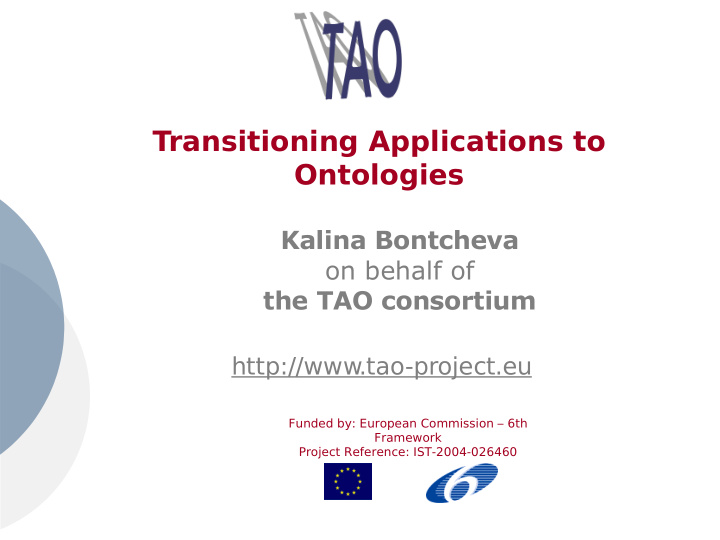



Transitioning Applications to Ontologies Kalina Bontcheva on behalf of the TAO consortium http://www .tao-project.eu Funded by: European Commission – 6th Framework Project Reference: IST-2004-026460
TAO Addressing the problem of transitioning legacy applications to ontologies What is a legacy software system: “A large software system that is vital to [an] organisation, but resists modification and evolution to meet new and constantly changing business requirements” Towards semantic-assisted software engineering 2
Legacy systems: Main Problems Built with languages and data models that are now out-dated Badly structured and hard to maintain Badly documented and understood Difficult to integrate with each other and with new systems Need for migration towards Web 2.0 applications & services 3
TAO: Towards a Low-Cost Migration Path Make transitioning to ontologies fast and effective Build a reusable transitioning process Minimize consulting time during migration and integration Minimize costs Reduce integration overheads and limit risk 4
Transitioning Process Semi-automatic learning of domain ontologies from software artefacts and legacy content Semantic augmentation of legacy content and web service definitions Heterogeneous & distributed semantic repositories Transitioning Infrastructure supporting IT providers 5
Partner Contributions Semantic annotation of text and multimedia content; GATE – widely used open-source infrastructure for text mining T ransitioning methodology Machine learning and data mining Transitioning infrastructure; exploitation Most scalable & efficient semantic repository Content and knowledge management Aviation case study; aircraft manufacturer 6
Transitioning Problems From legacy databases to ontologies Towards semantic-based software engineering Transitioning web applications towards ontologies and services 7
Aeronautics Case Study <>…</> <>… </> …. <> …</> LSA Database STANDARDS Semantic Content Augmentation Aircraft Maintenance Documentation Ontology Learning + Standards reuse Process Modelling Common Logistic Ontologies Process in OWL Receive M o - A/C Parts - M & O Tasks Invoke S 1 Invoke S 2 - Consumables OWL - Tools Receive S3 Invoke S 4 - Workloads Distributed - Maintenance Plans Knowledge Service Registry - Due lists Repositories - … Reply So Improving semantic interoperability in business processes through 8 Semantic technologies
Example Learnt Ontology – 400k triples 9
Example Learnt Ontology (2) 10
A Semantic Tagging Example Content Augmentation of Maintenance Manuals Annotation Interface … Ontologies Valve Non-Return-Valve -…. Non-Return-Valve -Denominations - Remove PUMP1 NR valve - Full: Non Return Valve PUMP1 NRV - Abbev: NRV - threshold: 3422 psi valve-1888 -Denominations - Full: PUMP1 Non Return - Check PUMP1 valve Valve valve-1838 and clean it - Denominations - Full: HYDR Non Return Valve Maintenance Data Repository Heterogeneous Knowledge Store Semantic Content 11 Augmentation
Transitioning Problems From legacy databases to ontologies Towards semantic-based software engineering Transitioning web applications towards ontologies and services 12
Learning Ontologies from Software Artefacts Software data sources execution logs… manuals, Web Code samples, source code, Comments, forums… pages, Structured data Unstructured data = networks = textual documents Document network = a set of interlinked documents; each link has a type and a weight 13
Creating a Document Network DocumentFormat DocumentFormat.class LanguageResource MimeType 2 RtfDocumentFormat DocumentFormat AbstractLanguageResource Document XmlDocumentFormat MpegDocumentFormat 14
Ontology Learnt from Software Code 15
Google-like Conceptual Search (1) 16
Question-Based Conceptual Search (2) 17
Transitioning Problems From legacy databases to ontologies Towards semantic-based software engineering Transitioning web applications towards ontologies and semantic-web services 18
Transitioning Web Applications Legacy application: database driven no interoperability Ontologies + SOA: Learn ontologies Manage complex WS 5 WS 1 WS 2 WS 3 WS 4 resources and knowledge links Tourism resources & links Use Service Oriented Ontology Application to integrate added value services CRM from other suppliers: BOOKING cartography, translation, … 19 booking services…
Software Demonstrations Learning ontologies from software code: http://www.tao-project.eu/demos-dec07/ontology-learni Supporting software developers with conceptual search: http://www.tao-project.eu/demos-dec07/semantic-se 20
Thank you! Questions? This presentation + demos: http://www.tao-project.eu/demos-dec07/ Kalina Bontcheva : kalina@dcs.shef.ac.uk 21
Contact Information For queries / further information, please contact the project co-ordinator: Kalina Bontcheva Department of Computer Science University of Sheffield Regent Court 211 Portobello Street Sheffield S1 4DP phone: (+44 - 114) 222 1930 fax: (+44 - 114) 222 1810 email: K.Bontcheva@dcs.shef.ac.uk 22
Recommend
More recommend